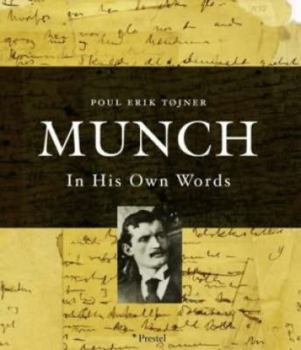Munch: In His Own Words
Select Format
Select Condition 
Book Overview
An exploration of the life and art of Edvard Munch, drawing on the artist's copious journal entries, notes, letters, literary exercises and photographs to present an approach to understanding one of... This description may be from another edition of this product.
Format:Paperback
Language:English
ISBN:3791328832
ISBN13:9783791328836
Release Date:March 2003
Publisher:Prestel Publishing
Length:224 Pages
Weight:2.20 lbs.
Dimensions:0.6" x 8.8" x 10.7"
Customer Reviews
3 ratings
Munch more than a scream...
Published by Thriftbooks.com User , 17 years ago
*Munch In His Own Words* is worth five stars just for the generous reproductions of the paintings, drawings, lithographs, and woodcuts that illustrate the text, as well as the selection of photographs taken by/and of Munch himself. These reproductions give one an idea of the stunning range and variety of Munch's complete life work, which goes well beyond his reputation primarily as the guy who painted `The Scream.' Nevertheless, in spite of this variety, one can still trace the red thread that runs through virtually everything he ever produced in his long career: a violently passionate and often antagonistic engagement with life and the world around him. So it is that the actual text of *Munch In His Own Words* can only be a bonus--and in this book we get extracts from Munch's personal journals and letters that offer first-hand insights into his complex psyche from which his extraordinary art emerged. Some of these texts are brilliant evocations of the artist's role as rebel and savior, others repetitive and obsessive, still others read like the ravings of a paranoid schizophrenic. Not having access to the complete texts, one wonders if they might have been edited and selected with an eye to a little more variety and little less repetition, but it's hard to complain. Munch is almost as explosive and idiosyncratic a writer as he is a painter and, on the whole, the texts provide a rewarding counterpoint and context to the art. Another bonus is the introduction and chapter openings by the book's editor Poul Erik Tojner. Sometimes elliptical to the point of incomprehensibility, studded with fancifully pretentious interpretations, Tojner does manage to provide some genuinely enlightening and provocative observations, perhaps none moreso than his suggestion that one can find striking parallels between the work of Munch and--of all people--Andy Warhol! Outrageous at first--and yet Tojner makes a wholly compelling and convincing argument for this unlikeliest of pairings. A rich and compulsively readable--not to mention eye-catching--volume, *Munch In His Own Words* is a great overall look at an artist who painted, in his own words, the only way he knew how: with his heart's blood.
Munch, the monastic
Published by Thriftbooks.com User , 18 years ago
Edvard Munch painted "The Scream." (BTW, his name is said like "monk", not like "bunch.") That was just one work from a long and dedicated life in art, and arguably not his defining work. Look at his "Sick Child" (p.15), and at the mother. Does she really have anything more in her than the Screamer, except just that little more strength a woman has than a man does? Only quietly enough for others to bear? I never thought much of Munch until I saw a display of his graphic work, largely woodcuts and some lithos. Then, I realized just how literal his painting style is. "As long as cameras can not be used in Hell or in Heaven, painters have no fear of competition." His paintings, and even more his prints, are about heaven and hell. Together, in the same picture, as his fevered mind saw them. Many of his painted and graphic works center on two monopoles: light and dark. Become aware of this frequent pattern, and you'll have almost the visual experience of seeing a magnetic field. His visual field contains a North and South pole, a source and a sink, a plus and a minus. In those, composition consists of defining the two, filling the space between the two, and emptying the space around the two. I recommend his work most highly to any student, at any level, who wants to learn composition by being kicked in the gut with it. Much of Munch's work is about stark, polar power. He also eliminates the placement of figure and ground, and creates the dichotomy of figure and ground. Half or more of his paintings show it: that aura emanating from the human being that sets it off from the material world around it. The background has no chance to interact with that force of person that emanates from each figure, so there must be a buffer zone between them. That, I think, explains the brushwork halo around so many of his human renderings: an attempt to define their visual limit, at the expense of any relationship to the world around them. Munch is good, if emotional truth means more to you than optical literality. He's also hard to take, and becomes harder to take as you learn more. I really think he put it all out there for us to see, whether or not we can take it all in. //wiredweird
If you want to know Munch
Published by Thriftbooks.com User , 20 years ago
I could not put this book down and when I finished, I felt as though I finally had some insight into Munch as a person as well as an artist. If you would like to have a better understanding of both the man and his paintings this book is for you.





